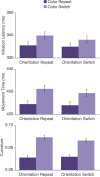Global attention facilitates the planning, but not execution of goal-directed reaches
- PMID: 27467450
- PMCID: PMC4979628
- DOI: 10.1167/16.9.7
Global attention facilitates the planning, but not execution of goal-directed reaches
Erratum in
-
Corrections.J Vis. 2017 Feb 1;17(2):3. doi: 10.1167/17.2.3. J Vis. 2017. PMID: 28166325 Free PMC article. No abstract available.
Abstract
In daily life, humans interact with multiple objects in complex environments. A large body of literature demonstrates that target selection is biased toward recently attended features, such that reaches are faster and trajectory curvature is reduced when target features (i.e., color) are repeated (priming of pop-out). In the real world, however, objects are comprised of several features-some of which may be more suitable for action than others. When fetching a mug from the cupboard, for example, attention not only has to be allocated to the object, but also the handle. To date, no study has investigated the impact of hierarchical feature organization on target selection for action. Here, we employed a color-oddity search task in which targets were Pac-men (i.e., a circle with a triangle cut out) oriented to be either consistent or inconsistent with the percept of a global Kanizsa triangle. We found that reaches were initiated faster when a task-irrelevant illusory figure was present independent of color repetition. Additionally, consistent with priming of pop-out, both reach planning and execution were facilitated when local target colors were repeated, regardless of whether a global figure was present. We also demonstrated that figures defined by illusory, but not real contours, afforded an early target selection benefit. In sum, these findings suggest that when local targets are perceptually grouped to form an illusory surface, attention quickly spreads across the global figure and facilitates the early stage of reach planning, but not execution. In contrast, local color priming is evident throughout goal-directed reaching.
Figures







References
-
- Albert M. K. (2007). Mechanisms of modal and amodal interpolation. Psychological Review, 114 (2), 455–469. - PubMed
-
- Anderson B. L. (2007). The demise of the identity hypothesis and the insufficiency and nonnecessity of contour relatability in predicting object interpolation: Comment on Kellman, Garrigan, and Shipley (2005). Psychological Review, 114 (2), 470–487. - PubMed
-
- Anderson B. L.,, Singh M.,, Fleming R. W. (2002). The interpolation of object and surface structure. Cognitive Psychology, 44 (2), 148–190. - PubMed
-
- Biederman I.,, Cooper E. E. (1991). Evidence for complete translational and reflectional invariance in visual object priming. Perception, 20 (5), 585–593. - PubMed
-
- Biederman I.,, Cooper E. E. (2009). Translational and reflectional priming invariance: A retrospective. Perception, 38 (6), 809–817. - PubMed
MeSH terms
Grants and funding
LinkOut - more resources
Full Text Sources
Other Literature Sources

